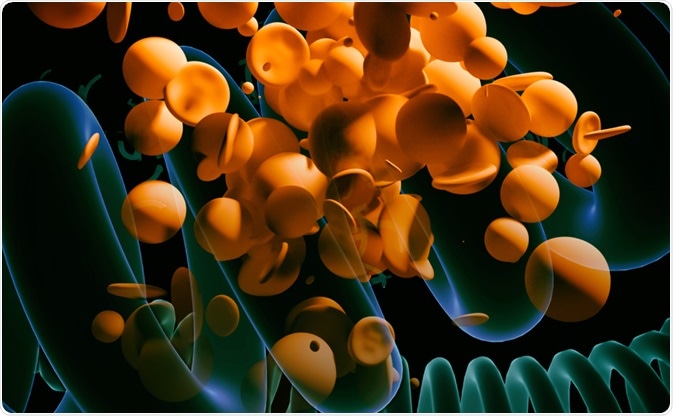Nanoparticles are widely used for fluorescent imaging of cells and tissues. They can be made of non-fluorescent materials, such as silica coated with fluorophores, or fluorescent materials, such as cadmium quantum dots.

GiroScience | Shutterstock
Fluorescent probes internalized into cells and tissue may bear functional ligands to recognize a specific target site within the cell or tissue. Cancer cells, for example, often overexpress a particular receptor on their cell membrane that can be targeted by a functionalized fluorescent probe.
Fluorescent probes that sense and fluoresce in the presence of a particular molecule, such as glucose, or in certain conditions such as a low pH environment are also used.
Modifying fluorescent nanoparticles for a specific target
Nanoparticles can be coated with many fluorophores allowing a fluorescent signal to be concentrated in a particular area. Nanoparticles with intrinsically fluorescent properties also show improved brightness compared with small molecule fluorescent probes.
Additionally, the large surface area of nanoparticles provides ample space to further functionalize the probe with targeting and protective ligands using simple click-chemistry methods, without compromising the intensity of fluorescence or the need for complex synthetic routes.
Thus, the surface charge, size, and shape of nanoparticles can be optimized to encourage cell entry, desired biodistribution, and uptake. For example, tumors exhibit the enhanced permeability and retention effect, where blood vessels constrict leading to accumulation of nanoparticles. Small nanoparticles tend to accumulate to a lesser extent than larger or high aspect ratio shapes due to their greater ability to navigate through the abnormal tumor vasculature.
Safety of fluorescent nanoparticles
Nanoparticles likely to be employed in biosensing or bioimaging are inert and non-toxic, or can be made so by surface modifications, while common small molecule fluorophores, such as Rhodamine 6G and Fluorescein have been shown to be toxic at moderately high concentrations.
Retention time
Nanoparticles possess far greater retention time within the body than small molecule fluorophores, allowing for improved imaging over a longer period. Non-specific binding by biomolecules present in biological milieu can deactivate the fluorescence of small molecule fluorophores, ultimately leading to its removal through the hepatobiliary or renal system.
Nanoparticles, however, can be coated with ligands, such as polyethylene glycol that prevent interaction between the nanoparticle and proteins. Nanoparticles that are intrinsically fluorescent remain completely unaffected by interaction with biomolecules in terms of the brightness of their fluorescence, though this is detrimental to biodistribution and retention time.
Theranostics: combined therapy and diagnostics
Nanoparticles are able to combine diagnostic and therapeutic properties into a single platform. In addition to the attachment of fluorophores and targeting ligands to the surface of the particle, drugs may also be conjugated allowing for simultaneous detection and treatment of disease. In cancer, the exact location of a tumor can be identified while the chemotherapeutic drugs are being delivered.
Certain types of nanoparticles can also act as radiation dose enhancers. Gold nanoparticles, which additionally bear plasmonic properties, are particularly strong radiation dose enhancers and can focus a beam of radiation within a highly localized area. This allows for a lower overall dose of radiation to be delivered to the patient, resulting in fewer negative side effects.
Further Reading
Last Updated: Nov 20, 2018